Most companies these days use Key Performance Indicators (KPIs) to help track the performance of various departments, and sales is certainly a department that is always focused on. Are the salespeople hitting their numbers?
If they are, there's a strong likelihood that nobody is looking too hard at any kind of metrics, things are working, so there's no need to. (if it ain't broken, why fix it?)
But if sales team is not hitting their targets, then suddenly the figures start becoming very important!
Now, no two companies are 100% alike, and so while there are common metrics that are used frequently, there is no definitive set that should be used.
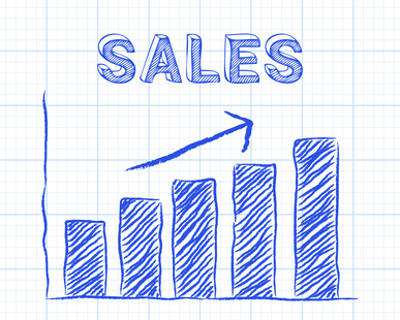
Now, I'm betting that whatever you use has some link to how many calls or visits the people make, depending on whether they are field based or telephone based, and there'll be some based on actual sales. Calls made, call durations, hours spent on the phone, meetings held are all really important, but I've got a set of figures that I believe anybody involved in personal sales should be looking at.
So, whether it's you as a salesperson looking at things to improve yourself, or you are the manager and you're trying to improve your team, they still apply.
Training will help, but where should the training be focused? On more general sales skills, or should they be specific? And this is where your KPIs and the figures that I suggest you track become important. They can guide you on where the training should focus.
Here's how I came to work with this set of figures, what they are, and what you should be looking for.
In the early 2000s, I started to manage a sales team that the sales director felt were grossly underperforming.
The team of just under 15 were made up of the usual suspects. These included what you would expect to see in almost any medium sized sales team. You had the people that had been there a good few years, and consistently hit their targets. On the opposite end of the spectrum you had some people that had only just joined the organization, and were still trying to find their feet.
And between those two extremes, 8-9 people that had been with the company from anything between 1 and 3 years, and all were not performing as they should. Some underperformed every month, while some did OK for one month, then dropped back down again.
My focus was thus on two areas; help the new people get going, and find out what could help the people that had been there a while, but were not regularly producing enough in terms of sales.
Before I arrived, nobody had kept any kind of statistics. So, as soon as I started, I began keeping statistics, and went back and put together stats for each person. It immediately highlighted an area for one person. Our biggest product was selling a Microsoft technician's package, called an MCSE. It was a very popular package, and very high value. An essential combo for hitting targets.
The good performers sold 2-3 every month. The one person who was struggling had only sold one MCSE in 2 years! Yet he was selling a lot of the smaller, low value items, like the odd day of Excel training. It immediately meant we had an area to focus on. Did he not understand the product well enough to explain it clearly to clients? Or if not, what could be the problem? We now had an area to work on.

If you'd like to learn more about selling skills, why not take a look at how we can help?
Boost your sales skills with our online courses.
RRP from $39 – limited time offer just
$12.99
And just like that, statistics had showed us what to look at to improve. So the rest of this article will be about specific areas that you can look at in order to improve. If you are a sales person, you should be keeping these yourselves. If a sales manager, are you keeping them for each of your team? You need to be doing so, either to improve personally, or to help your team member. Sit down with them once a month, look through the figures, and work on areas that can be improved.
1. Actual sales figures
This includes all your typical monthly and quarterly figures, such as the number of deals per month, value of deals per month, the average value of deals for the month. But do you have running totals, not just for that month or quarter, but since they started? So could you compare their performance at 18 months to how others were doing after 18 months? It becomes useful to have, so that when sitting down with the person in a review, less of the discussion is subjective. You can definitively state that they are producing less than X, Y or Z were at the same point.
Below are the example sales figures for a particular salesperson, for a specific month (Picture A), and also a running total (Picture B).
Picture A:
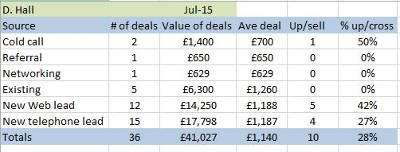
Picture B:
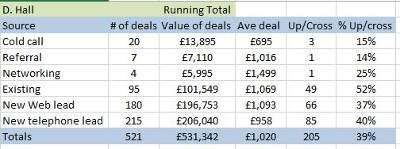
2. Closing percentages
This can be really difficult to track. For example, can you track exactly how many referrals you have had, or your staff member had? Perhaps not, but track what you can. If new telephone leads and web leads are allocated out, you need to track exactly what numbers they received, and what percentage of those they closed.
The example below (Picture C) shows the areas that could be tracked for a specific individual. You can then monitor those closing percentages for that person over time, to pick up trends, or compare them with other salespeople at the organization.
Picture C:

3. Sales by source
Track where people's sales are coming from in terms of source. You will know your own industry, but possible sources could include: existing clients buying more, referrals, networking, cold calls, leads from your website, new inbound calls (from different areas eg. adverts on the internet, chambers of commerce and more). Having statistics like this will again show where to help people develop. I had a good sales person that in 3 years had not once obtained a referral. Adding that one dimension could make them great! Look at each person, where their strengths and weaknesses are, and aim to improve on those weaknesses.
The table below (Picture D) shows the source of the deal for a specific sales person for a particular month. You can then also represent the data in graphs, showing how certain sources provide the bulk of their sales (Picture E).
Picture D:
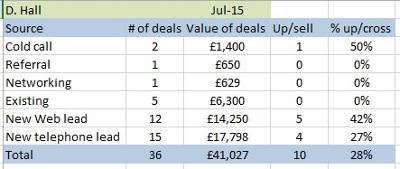
Picture E:
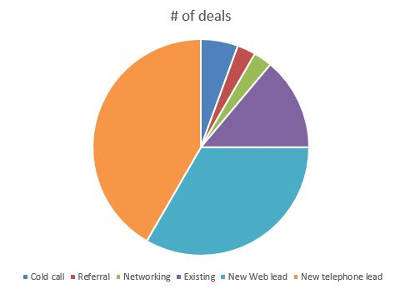
4. Sales by product or product range
As I mentioned in my example, I had a salesperson struggling to sell the best product, yet he could sell loads of other small products. So he could sell, he just had a blind spot. Similarly, your staff may struggle with certain things, and working on those will help tremendously.
The table below (Picture F) shows how a particular salesperson has sold each product type, within a calendar month. In this example, the lack of any sales for product C may be an anomaly, but if consistent, you can then question if there is a problem in regards to that product only. The chart below (Picture G) represents the same thing. There is no segment for the colour for product C.
Picture F:
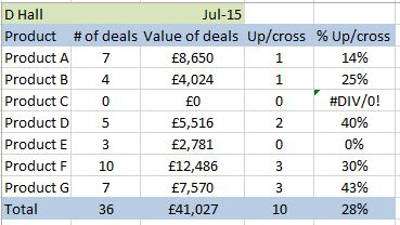
Picture G:
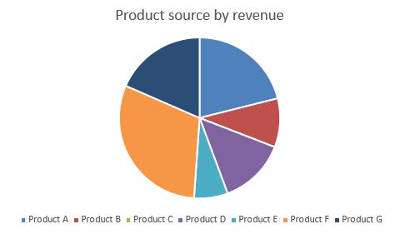
5. Number of up-sells and cross-sells
These you should record as both a number in itself, but also as an average of the number of deals closed. And finally, what is the average value of the upsell or cross-sell? All salespeople should be trying to upsell or cross-sell on every deal. Perhaps the person focuses on closing the deal, and then backs off asking for the add ons, and both he and the company are missing out what are often the high profit extras. One of my team was like that. She focused on her closing percentage, and once the deal was closed, was mentally moving onto the next one already.
The graph below (Picture H) shows the percentage of deals that the person is closing either an upsell or a cross-sell, based on the source of the deal. Again, it may just be a monthly anomaly, but if repeated consistently, why does the salesperson struggle to upsell or cross-sell to clients that are found from those particular sources? Can you change that?
Picture H:
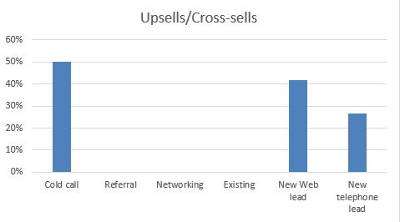
6. Duration of time to close deals
Different markets see different time frames that the average deal takes. So you cannot compare to other industries, but you can compare your staff to each other. Do some take longer to close deals than others? Is there a reason for this? You may be surprised at the findings here. The obvious answer is that the sooner you can close a deal, the better. And 99% of the time that is correct. But for the team that I used as an example, the higher value MCSE deals took a lot longer to close than people just looking for Excel training. So, in this team, the best salesperson actually had a longer average duration, than the person selling loads of Excel, but no MCSEs. When that person then started to actually close more MCSEs, their average duration went up, not down, yet they were a better salesperson.
Normally this is just represented as an average number of days (or other time reference) that it takes to close. You simply have the length of each deal, then arrive at a sum total of all those days, divided by the number of deals themselves. This will give you the average number of days for each closed deal.
7. Percentage of meetings held that ended up in closed deals
Not every sales person attends meetings offsite at a client. Some may be telephone based, or the client comes to you, but if you or your staff do go offsite, you need to measure those closing rates (Picture J). Also, is that rate better if you go alone, or if two people go, maybe the salesperson and the sales manager? I'll bet that you find it is, as subconsciously, your client will think you are taking them more seriously.
Picture J:
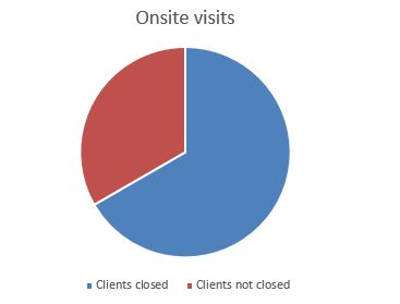
One final thing here about meetings; this is not about deals closed at the meeting. You may go out, deliver a presentation in a meeting, and then get the deal a week later. That counts here too.
So I have suggested 7 specific areas to measure. Now, I'm not suggesting that you drop all of your other Key Performance Indicators (KPIs). You still may be monitoring number of calls made, time on phone, number of meetings arranged/attended etc. Those are all valuable to assist in whether the person is doing their job. The ones that I have listed will show how well they are doing their job, and will allow you to improve more by analysis than simply telling the person to make more calls. So do these in conjunction with your other KPIs.
Lastly, these days, CRM systems could be doing a lot of this for you. And since it's automated, it obviously saves time. But for whatever is not automated, that you have to do manually, as I did all of this using Excel spreadsheets. The benefits you get are more than worth the time it takes. Once set up, just keep updating things. I then sat down with each salesperson once a month, relooked at their figures, and worked on what we could do to improve them that month. It's a process of continuous improvement. The rewards you will get from this are improved sales, either just for you, or your team, and I guarantee you it can change the way you sell forever. With my team, the bottom two thirds of the team had tripled their sales within 6 months. It made a company on the borderline of making a loss into one that was suddenly really profitable, and could then afford to make some expansions that had been planned for ages, but were not in a financial position to do so. Try these and yours could too.

If you'd like to learn more about selling skills, why not take a look at how we can help?
Boost your sales skills with our online courses.
RRP from $39 – limited time offer just
$12.99




































